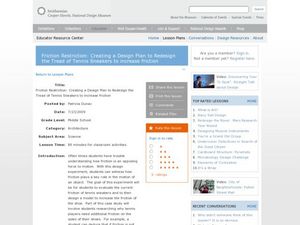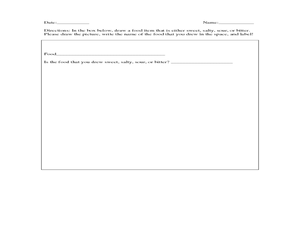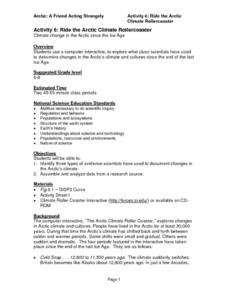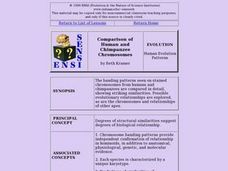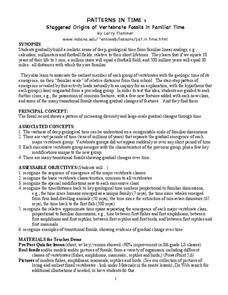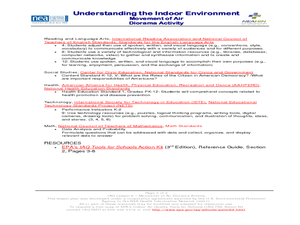Curated OER
Friction Restriction: Creating a Design Plan to Redesign the Tread of Tennis Sneakers to Increase Friction
Students evaluate the friction of tennis sneakers and redesign them to increase friction. In this physics lesson, students calculate starting, sideways and forward stopping friction. Using quantitative data, they prove that redesigning...
Curated OER
Fractals Forever or Obvious and Hidden Order
Students discuss ways computers use properties of similar figures to generate scale models and create scenes. they describe patterns they have seen on a fern, pineapple, or pinecone. Students research Benoit mandebrot, H. von Koch and...
Curated OER
Catapults
Students are introduced to the concept of a catapult and how it is used with the help of a media presentation. They use catapults in a large, open area and record the distances objects travel. Students use the scientific method while...
Curated OER
Capacitors
Students explain the concepts of charge storage and how a capacitor works. They construct a capacitor and measure the stored charge using the appropriate equipment and measurements. They also demonstrate capacitance and how it can be...
Curated OER
Tropical Atlantic Aerosols
Young scholars analyze NASA data from the Multi-angle Imaging Spectroradiometer. In this NASA data lesson, students access an assigned website to examine information from the MISR on the Terra Satellite. They determine how desert dust...
Curated OER
Aging of Trees
Students examine tree rings to determine its age. In this tree ring lesson, students examine core tree samples, identify the tree rings, and then determine its age. Students complete a worksheet, deciding which of the two core sample is...
Curated OER
Archery
Learners study archery. In this archery lesson, students develop basic archery and hunter safety skills. Learners discuss the history of archery and bow hunting.
Curated OER
Looking into the Past (Archaeology)
Students discover how to be an archaeologist. In this archaeology lesson, students research the basic information about an archaeologist. Students then observe different artifacts and learn what questions to ask in order to discover the...
Curated OER
The Five Senses
Pupils use their senses to identify a variety of items in mystery boxes after listening to a read aloud of Aliki's, "My Five Senses." They taste and smell items to identify them before completing a Senses Literature Log. They label the...
Curated OER
Hands Off
Students perform a handwashing experiment to see if a difference can be detected in the number and types of microbes on our hands after various types of cleaning. They will also demonstrate that they have learned the whys and hows of...
Curated OER
Model Mania
Eighth graders study the conservation of matter. In this chemical reaction lesson students examine what happens during a chemical reaction and complete a lab activity.
Curated OER
Terrific Taste Buds
Learners explore descriptive writing by eating food in class. In this descriptive word lesson, students assess different foods in class such as jelly beans and utilize their vocabulary to describe the taste. Learners read the story...
Curated OER
Second Graders Create Their Own Social Studies Book
Students develop their own social studies textbook. Students gain knowledge of American immigration and Ellis Island. Students discover the process of becoming a naturalized citizen and what it means to be a citizen
Curated OER
Eyewitnesses to Change
Students explore recent changes in the Artic's climate that have been observed by Artic residents. They watch videos, take notes and create a concept map. They also look at historical weather data from a specific Artic community. The...
Curated OER
Ride the Arctic Climate Rollercoaster
Students view interactive CD-ROM entitled The Arctic Climate Roller Coaster, research evidence of changes in climate through the years, record ways people responded to changes, and create short presentations to share evidence with...
Curated OER
I Don't Think We're in Kansas Anymore (Grades 2-5)
Learners give examples of erosion and weathering processes. They determine causes of America's Dust Bowl phenomena.Students define erosion as the condition in which the earth's surface is worn away by the action of water and wind.
Curated OER
Mystery of the Matching Marks
Students view a Power Point and complete activities related to genetic evidence of human evolution. In this molecular evolution lesson, students view and discuss a provide presentation. They search for the "tell-tale telomere" and...
Curated OER
Comparison of Human and Chimpanzee Chromosomes
Pupils actively engage in the careful analysis of chromosome banding patterns and identify examples of inversion in homologous chromosomes.
Curated OER
Patterns In Time
Seventh graders examine fossils. In this vertebrate fossils lesson plan students view a demonstration.
Curated OER
Observations and Inferences
Young scholars observe how to distinguish observations form inferences. In this examining inferences lesson students list observations relating to the activity and discuss the importance of them.
Curated OER
Using the Problem Solving Wheel
Students solve problems about air quality. In this air quality lesson, students receive a scenario from the problem wheel and find solutions to the air quality problem. Students write a paragraph summarizing what they learned.
Curated OER
Movement of Air Diorama Activity
Learners make a diorama to illustrate the process of mechanical airflow. In this movement of air lesson plan, students discuss ventilation and air movement indoors. Learners discuss ventilation systems and study pictures of the systems....
Curated OER
Deck of Word Cards
Learners study vocabulary words associated with indoor air quality. In this air quality lesson, students participate in a word card game where they write sentences for the vocabulary words given. Learners then check the original teacher...
Nazareth College
Create Your Own Tornado
Third graders identify key concepts and definitions about tornados. They work in small groups of three to four to create mini-tornados. After reading Tornado Alert as a class, 3rd graders discuss tornados and fill out a KWL chart.


